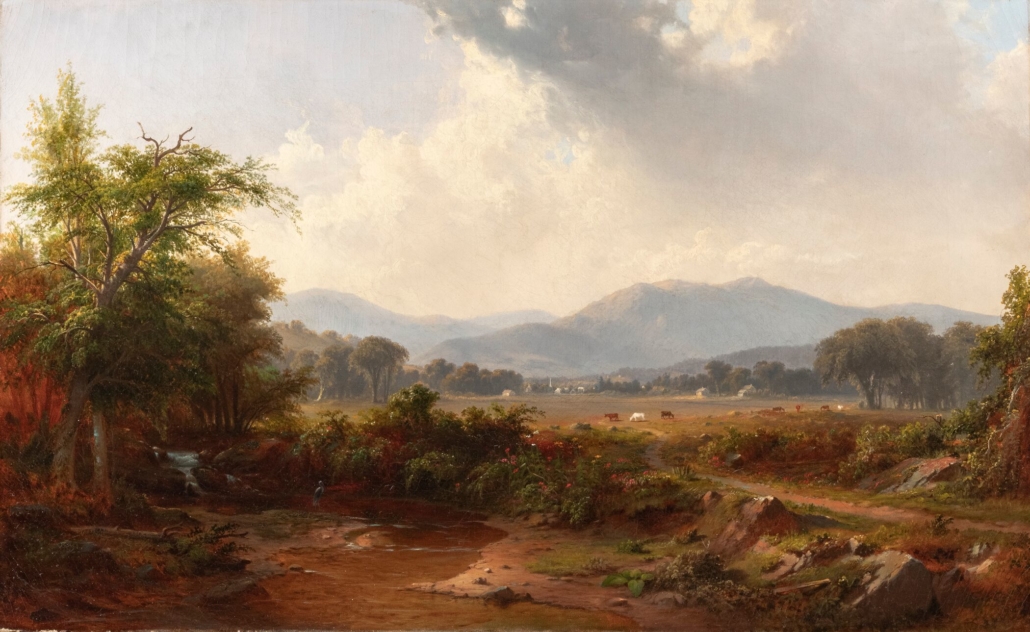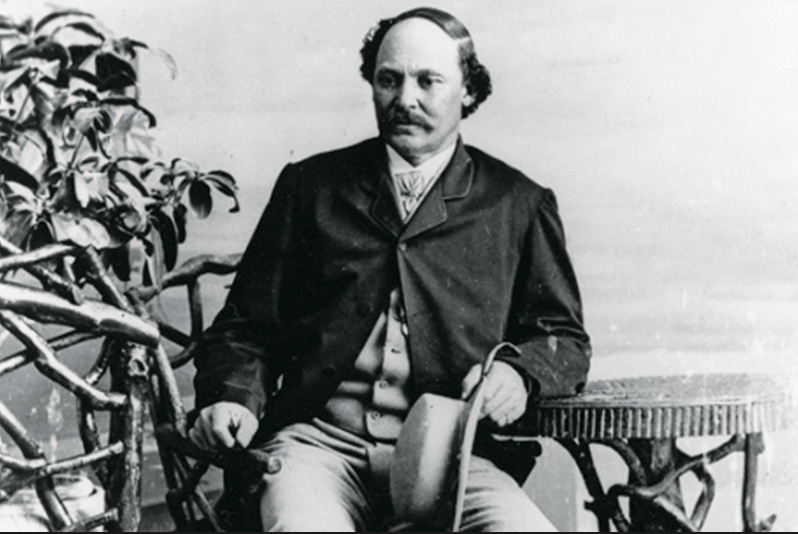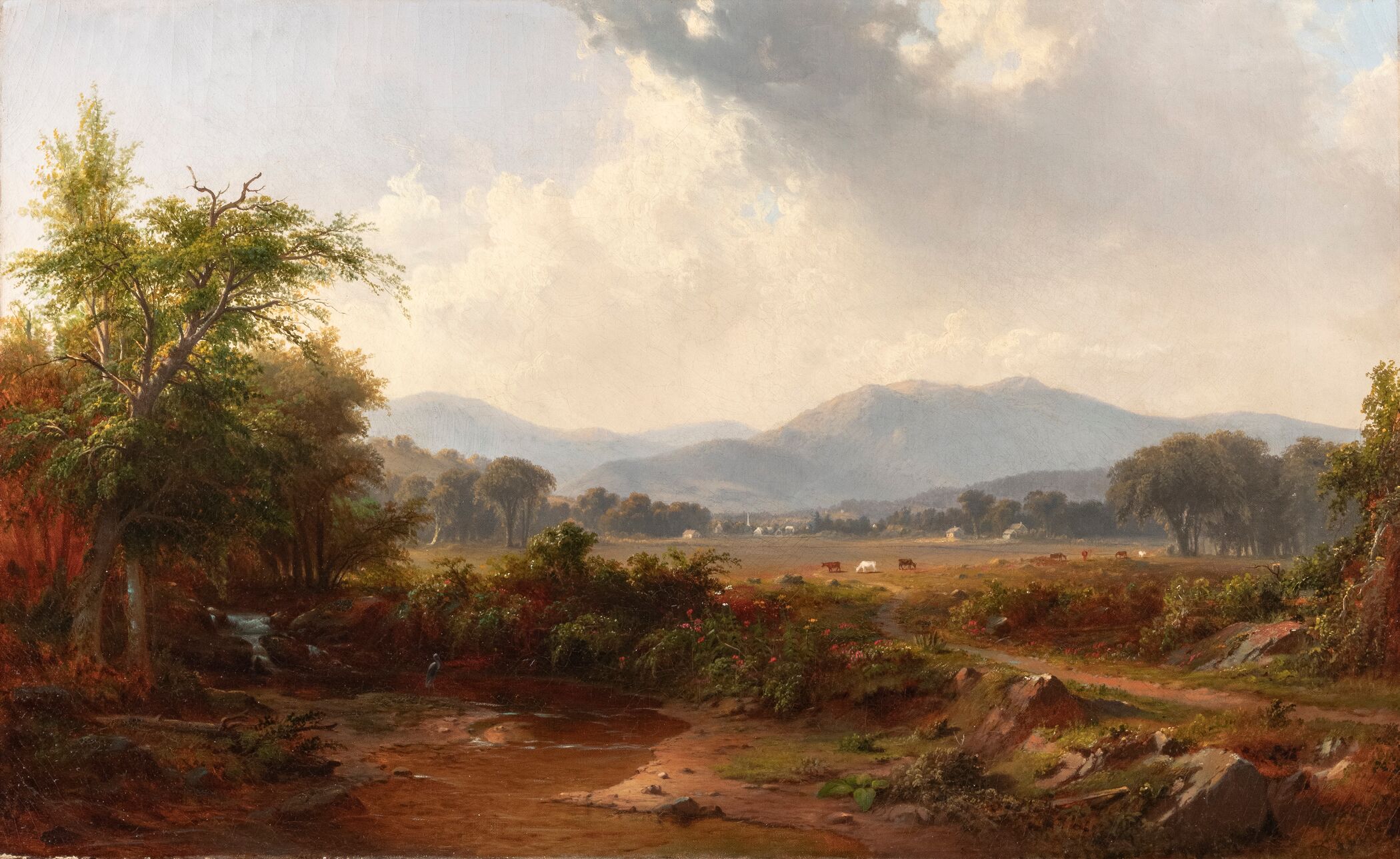
WINTERTHUR, Del. — Winterthur Museum, Garden & Library has acquired the painting Short Mountain by Robert S. Duncanson (1821-1872), the foremost African American landscape painter of the 19th century. A special study day, “Discovering Duncanson,” will be held on December 6, 2019, featuring prominent scholars Gwendolyn DuBois Shaw, Ph.D., of the National Portrait Gallery, and Dr. Martha Jones, Ph.D., of John Hopkins University.
“If you want to study Duncanson as a painter,” Associate Curator of Fine Art Stéphanie Delamaire, Ph.D., said, “you want to see this picture.” Registration for the Duncanson study day will begin online September 6, 2019.
Robert S. Duncanson was an African American artist who was widely acclaimed by antebellum critics as the “best landscape painter in the West.” Short Mountain, an outstanding composition in pristine condition for its age, equals or surpasses many examples of the mid-nineteenth century American school of landscape painting.
Short Mountain depicts a panoramic view with a stream, pasture and mountains inspired by the southern Appalachian mountains of Tennessee, where Duncanson was traveling in the early 1850s.
“This canvas constitutes a crucial addition to Winterthur Museum’s collection, which had not included a painting representative of this major movement in American culture,” said Delamaire. Duncanson’s painting also contributes to Winterthur’s growing collection of needlework, furniture, and other works of art and material culture created by African Americans, thus constructing a more inclusive view of artistic creation in 19th-century America at Winterthur. The painting will be on view in the galleries in December, where it will present many opportunities for teaching.”
Delamaire and Matt Cushman, conservator of painting at Winterthur, authenticated the unsigned Short Mountain in part from its technical style—as compared to other Duncanson works from the time—in part from corresponding exhibition records, and in part by a canvas stamp from a dealer in Troy, New York, whose date corresponds to the period of Duncanson’s travels in the area. Short Mountain remained in the family of its original owner until 2000, when it was sold to a private collector.
Delamaire acknowledges a debt to the late Joseph D. Ketner II for his pioneering scholarship on Duncanson.
Short Mountain bears a striking resemblance to a reviewer’s 1851 description of a painting displayed in the Western Art-Union gallery: “Duncanson’s View on Clinch River is a fine picture. It gives a view of the stream for some distance—of a plain on the opposite side, and of hills and mountains in the distance. The water has fine effects, and the distance is revealed as faithfully as in any picture we have seen by this artist, and his distance is good almost invariably.”
Duncanson is represented in collections of such national and international institutions as the Cincinnati Art Museum; the Metropolitan Museum of Art; the Smithsonian American Art Museum; the Museum of Fine Arts, Boston; the Detroit Institute of Arts Museum; the Montreal Museum of Fine Arts; and the Royal Court of Sweden.

Robert Seldon Duncanson was born in 1821 in Fayette, New York, the grandson of Charles Duncanson (ca. 1745–1828), a freed enslaved man from Virginia. The family had moved into the Military Tract of Central New York, where the federal government granted land to Revolutionary War veterans, suggesting that Charles may have earned his freedom for his military service.
Duncanson grew up in a later moved to Monroe, Michigan, a thriving commercial town at the western end of Lake Erie. After apprenticing in the family trade of house painting, decorating, and carpentry, he formed his own firm of painters and glaziers in Monroe in 1838 in association with a man named John Gamblin. The firm stopped advertising in 1839, probably because Duncanson had decided to move to Cincinnati.
A city at the crossroad of major East and West transportation routes and on the border between the North and the South, Cincinnati was then becoming a leading economic and cultural center west of the Appalachian Mountains. The bourgeoning city would produce some of the most important artistic and cultural figures of the time, including Hiram Powers, Lilly Martin Spencer, and Harriet Beecher Stowe. In spite of Ohio’s Black Laws, pervasive racial discrimination, and racial violence, it was a stronghold of abolitionism and became home to a short-lived but thriving African American community attracted by the opportunities it offered. Within this community, a small middle class emerged. It established churches, schools, and benevolent societies, and it included an active group of African American artists.
Duncanson’s career is an integral part of this community’s story. In 1841, the artist moved to the village of Mount Pleasant (now Mount Healthy), about 15 miles north of Cincinnati. First operating as an itinerant portrait painter between Cincinnati, Monroe, and Detroit, Duncanson also produced “fancy pictures” and “chemical paintings” in collaboration with the African American photographer James P. Ball, who moved to the region in 1845 and opened a daguerrian gallery in 1851. Duncanson would contribute to Ball’s monumental anti-slavery panorama, Ball’s Splendid Mammoth Pictorial Tour of the United States Comprising Views of the African Slave Trade, which toured the country in 1855.
In Cincinnati, Duncanson benefitted from the presence of a circle of active art patrons, artistic institutions, and artists who all contributed to the emergence of a regional school of painting influenced by Thomas Cole and the Hudson River School. In 1847, the Western Art-Union was established in the city with a gallery that exhibited landscapes by Cole, among others. A Cincinnati patron, George K. Shoenberger (1809–1892), who had bought Cole’s series of paintings The Voyage of Life (National Gallery of Art), exhibited it to the public at the Western Art-Union in 1848 in the aftermaths of the painter’s death and during the broad press coverage of Cole’s memorial exhibition.
Duncanson’s career reached a turning point in 1848. Inspired by the study of Cole’s The Voyage of Life andencouraged by the commission of a landscape view of Cliff Mine, Lake Superior (1848) by abolitionist minister Reverend Charles Avery, Duncanson left the city and set out on a sketching trip to the upper peninsula of Michigan to devote himself to landscape painting.
Upon returning to Cincinnati, he moved to a studio adjacent to William L. Sonntag (1822–1900), an established landscape painter in the city, whose work Duncanson initially emulated and later surpassed. Between 1846—the date when the famous abolitionist newspaper The Liberator first mentions Duncanson as an important artist—and 1853, the painters’ career and artistic abilities advanced at an amazingly fast pace.
Between 1850 and 1852, Duncanson undertook several sketching trips, traveling up the Ohio River through Pennsylvania, New York, and Michigan, and south to Kentucky, Tennessee, and North Carolina, where he travelled at least as far south as Asheville. One of the earliest known landscapes from this period, A View of Asheville, North Carolina (Museum of Fine Arts, Houston), is signed and dated from the year 1850. The following year, Duncanson exhibited another Southern composition, The French Broad, North Carolina, at the Western Art-Union gallery, where the work was praised as one of Duncanson’s best pictures.
Short Mountain was painted exactly during this period; the canvas stamp on its back was used by the manufacturer only between 1850 and 1853. The painting offers a direct encounter with the rising talent of this extraordinary artist.
The condition of Short Mountain is remarkable for a painting of its age. It is unlined, and it has never been removed from its stretcher. Corresponding damages on the stretcher verso and on the frame verso indicate that the painting and frame are an original pairing and that the frame has only been removed twice—once when the painting was studied in Winterthur’s painting laboratory.
Examination under magnification and using ultraviolet illumination reveals that a thin layer of natural resin varnish was intentionally left behind in the darkest passages in the lower left. This finding, combined with the observation that the delicately painted branches and green foliage silhouetted at left against the white clouds remain intact, indicates that Short Mountain was expertly cleaned during the only conservation treatment it received since it was painted. Overall, the painting is not only in a remarkably excellent state, but also a perfect representation of Duncanson’s ability as a landscape painter at a turning point in his career.
Click to visit Winterthur online.
# # #


